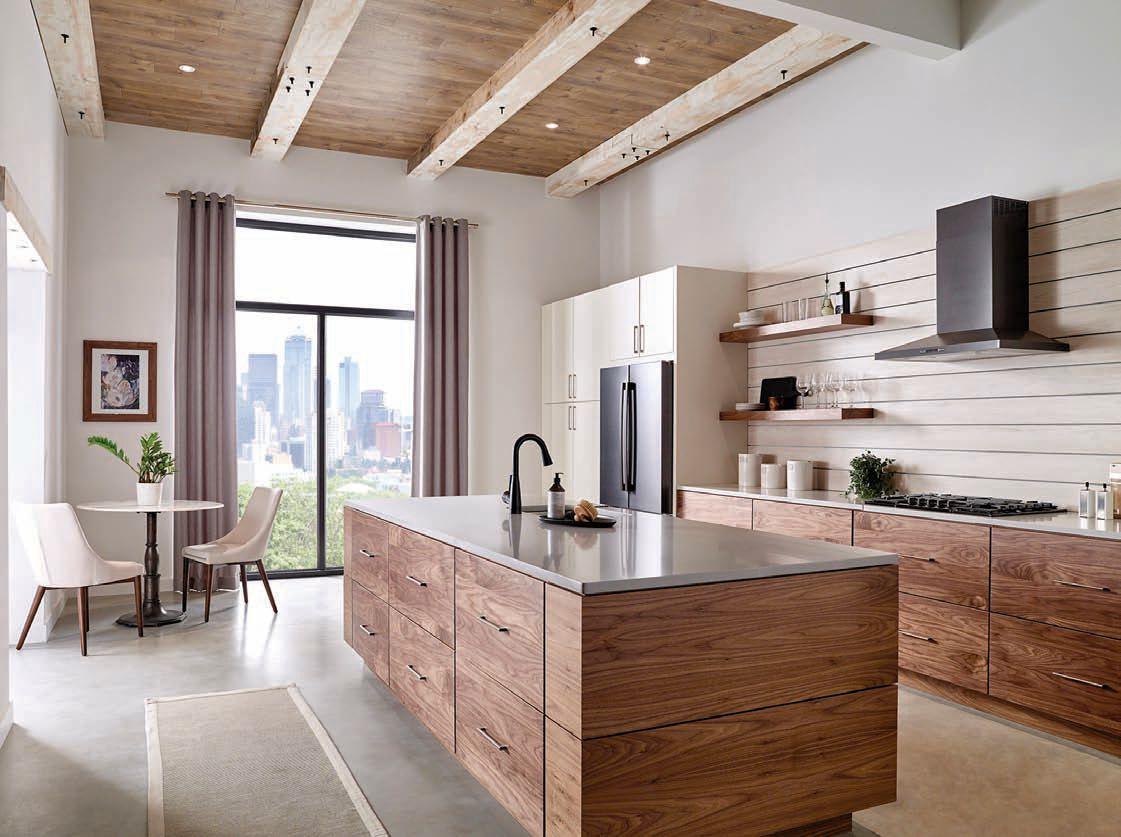
5 minute read
Soft Spot for Hardware
Photo courtesy of Kirsch Drapery Hardware
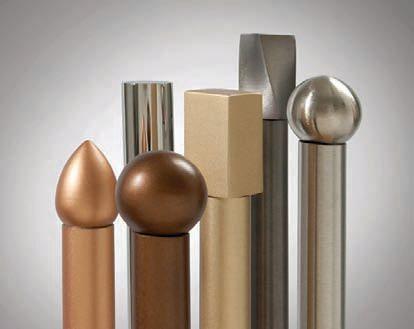

Photos above and below courtesy of Orion Ornamental Iron Photo courtesy of Orion Ornamental Iron


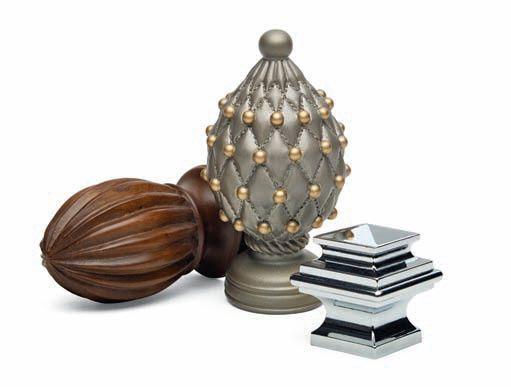
Photo courtesy of Orion Ornamental Iron Photo courtesy of JF Fabrics
BY SOPHIA BENNETT
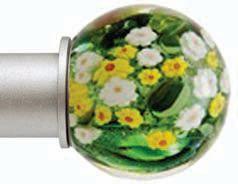

Having the right hardware can make or break a window covering project. But beyond just the physical hanging of window treatments, hardware can add elegance, convenience and uniqueness to a space. It’s no wonder that plenty of people have a soft spot for this category. Heading into the new year, we examine trending looks, products and materials.
Simple and Refined
As is true of window treatments themselves, modern consumers seem to prefer simple hardware. “Smaller, more refined styles are trending,” says Sarah Frost, brand manager for Kirsch Drapery Hardware, a division of Turnils North America. “Generations across the board are looking for simpler designs and more neutral colors to complement their decor. Simple styles allow for more versatility.” Kirsch’s classic Designer Metals Collection continues to grow in popularity year after year, which reflects this desire.

“Our clients seem to be leaning toward clean and simple,” says Larry Kaufman with Morgik Metal Designs. “The older, ornate wrought iron designs are not very popular right now.”
The minimalist movement isn’t completely dominating the U.S. According to Lisa Nicholl, senior vice president of sales and marketing for JF Fabrics, the farmhouse, vintage and modern classic genres are pushing some people to consider more ornate, standout hardware made with less traditional materials such as acrylic rods mixed with metal or “aged” wood rods with postindustrial metal finials. And there are still some parts of the country where people insist on larger, more traditional rods and highly decorative finials.
But in cities and with younger people, simple and streamlined is definitely in. “Our Italian Collection is very popular in urban and metro areas,” says Sunil Patel, CEO of Orion Ornamental Iron. “Younger populations like the clean, simplistic look for hardware. There is a trend toward transitional and contemporary.”
Photo courtesy of Morgik Metal Designs Photo courtesy of Orion Ornamental Iron

Rods Versus Tracks
In general, rods are becoming less popular as people move away from stationary panels and toward more modern looks. “It seems that traversing systems are what we are selling most often,” says Cali Cochran, national account manager with Forest Drapery Hardware. “The benefit to the traversing decorative metal rods is that you can have extremely long, heavy-duty rods but can still bypass though the brackets.” Track systems, too, are seeing much higher sales as more people request motorized window treatments.
Rods are still selling, but when they are used, they tend to be smaller. “Our bestselling rod sizes are 1 inch, 1¼ inch and 1½ inch,” says Patel. “Note the smaller diameters than the traditional 1⅜inch and 2-inch diameter.”
Rods are getting wider as windows grow in size, but they’re also getting smaller in diameter, says Glen Tyson, products division supervisor at Merrill Y. Landis. “I’m hearing customers really don’t like the look of a big bulky rod. They want to see as little as possible of the pole hardware.”
To that end, the company has developed a side panel rod that staff also refer to as a floating panel rod. “It’s the greatest illusion in drapery side panels,” Tyson quips. “We make simple rods for just side panels that, when you hang pleated drapes, you don’t see any hardware. This is great because you don’t have to decide on any hardware that is going to distract from the beauty of your drapes. You only see the drapes. Hence, the appearance the panels are floating in midair.”
“Architectural influences are leading to new shapes in rods, rings and finials, including squares, thin H rails, rectangular and square rings, and cubist-shaped finials,” says Patel. “Round and square poles are popular for us.” Also selling well is the Modern Barn Rail Track. Inspired by sliding barn door hardware, the traversing mechanism sits on a rail pulley, allowing the rings to traverse with minimum effort.
Finials or French Returns
The move toward less ornate designs is reflected in finials too. “Our bestsellers are the simple finials and rods,” says Kaufman. “Our custom disc finials and balls are always popular.”
Kirsch’s bestselling finials are the classic ball styles or simple shapes, according to Frost. Orion’s customers want crystal products, those with simple, clean shapes, and components with architecturally inspired designs.
“Trending finials seem to be contemporary and simplistic. Many customers will go with an end cap, leaving a clean end,” says Cochran. “Another trend is replacing a finial with a French return. Everyone loves the French returns.”

Thomas Berry, CEO of Helser Brothers, agrees. “More and more designers and consumers are opting out of finials altogether and gravitating toward beautiful French poles. Traversing French poles are one of the hardest items for us to keep on the shelves.” Aside from the look, consumers seem drawn to the ability to traverse around the bend and have the drapes fully cover the windows.
Photo courtesy of Kirsch Drapery Hardware
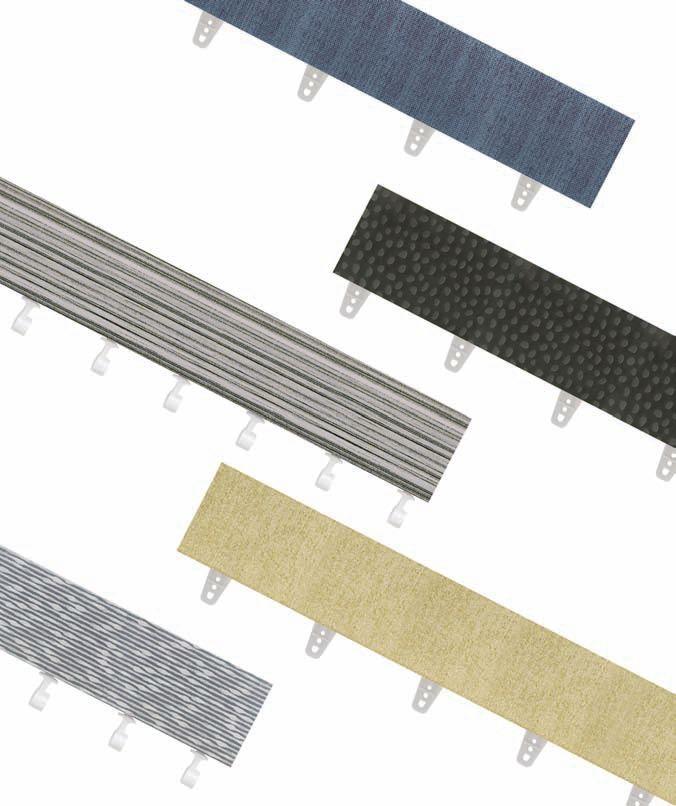
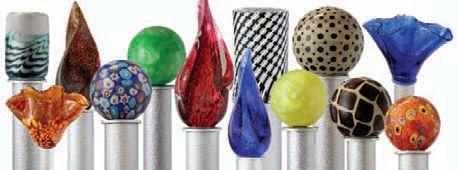
Ona Drapery’s ArtGlass finials
Bring on the Color!
While metal and clear acrylic may be the most popular hardware offerings, there are some fun options for people who want a pop of color with their hardware.
Earlier this year, Kirsch launched the newest fascia for its Estate Traverse Rod collection (left). “Varia is a revolutionary eco-resin that offers a burst of color, but also incredible textures unlike anyone has seen before,” says Sarah Frost with Kirsch Drapery Hardware. “Kirsch selected a range of 12 options that bring a whole new set of possibilities to the traversing drapery rod world.”
Ona Drapery offers colorful ArtGlass finials. “They are a fun and unique way to add a boho pop of color or make the design unique to the customer’s home,” says Karl S. Keishold with Ona Drapery.
Ona Drapery’s ArtGlass “Purple Fan” finial







